
One of our best-selling tours, this comprehensive 14-day itinerary covers key destinations in Vietnam, including Hanoi, Sapa, Ha Long Bay, Hue, Hoi An, Ho Chi Minh City, and the Mekong Delta. Experience the rich culture, stunning landscapes, and vibrant cities that make Vietnam such a captivating destination.
Our tip: If you're keen on capturing the beauty of golden rice paddies in Sapa, consider traveling in August. Sapa town is nestled at the head of a deep valley adorned with magnificent rice terraces that have been farmed for centuries. Backdrops don’t get much more spectacular.
Start off in Hanoi, famous for its bustling streets and mouth-watering street food such as Bun Cha. Hanoi is also the birthplace of Pho, the famous Vietnamese noodle soup that you've probably heard of. The holiday then continues with a trip to Sapa, a beautiful mountainous area that you can reach from Hanoi either by driving or taking a luxury overnight train. Of course, any visit to northern Vietnam can't be complete without an overnight Ha Long Bay cruise; one of the things our clients love is to relax and soak in the view from their private balcony.
Next, visit Hue, famous for its ancient citadels and royal tombs. Founded in 1687, Hue has always been considered the soul of Vietnam - the center for scholars, poets, philosophers, and emperors. From Hue, it's only a 3.5-hour drive to Hoi An, a city that was once voted the 'best city on earth' by readers of Wanderlust Magazine. Hoi An is renowned for its cobbled streets and distinctive yellow shopfronts adorned with colorful lanterns, and delicious Vietnamese Banh Mi that you will see at every street corner.
From Hoi An, it is an hour flight to Ho Chi Minh city (or Saigon), a city which is surprisingly under many travelers' radar but exudes so much charm, hospitality, and a fabulous selection of southern cuisine. Wrap up your holiday with a visit to the Mekong Delta, famous for its fruit farms, flower orchards, labyrinthine canals, and delightful floating markets .
Your experiences includes:
If you want, you can add a few nights at the beautiful island of Phu Quoc (1h flight from Ho Chi Minh city) at the end. We recommend this option if you travel between November - April when Phu Quoc is at its best weather wise. Alternatively, you can also fly to Siem Reap (1h10m flight from Ho Chi Minh city) and spend a few days exploring the majestic temples of Angkor.
As luxury travel experts for Vietnam we can hand pick the finest accommodation for your holiday.
Our experienced guides who know these destinations like the back of their hands will ensure you don't miss a single highlight and they'll share with you fascinating insights along the way. All of your tours are private, tailored to your preferences and interests.
You'll have access to the best attractions, avoiding the crowds and immersing yourself fully in the experience.
Our dedicated local team is available 24/7 to provide ground support, ensuring your journey is seamless and worry-free.
Our price includes:

Only in Hanoi: a small street corner becomes a tapestry of colours — an ancient banyan tree draped over a temple gate, a hat seller resting on the step, lanterns swaying above the buzz of scooters and the clutter of tiny shops.
Xin chao! Welcome to Hanoi!
Upon arrival, your guide or driver will be waiting to transfer you to your hotel.
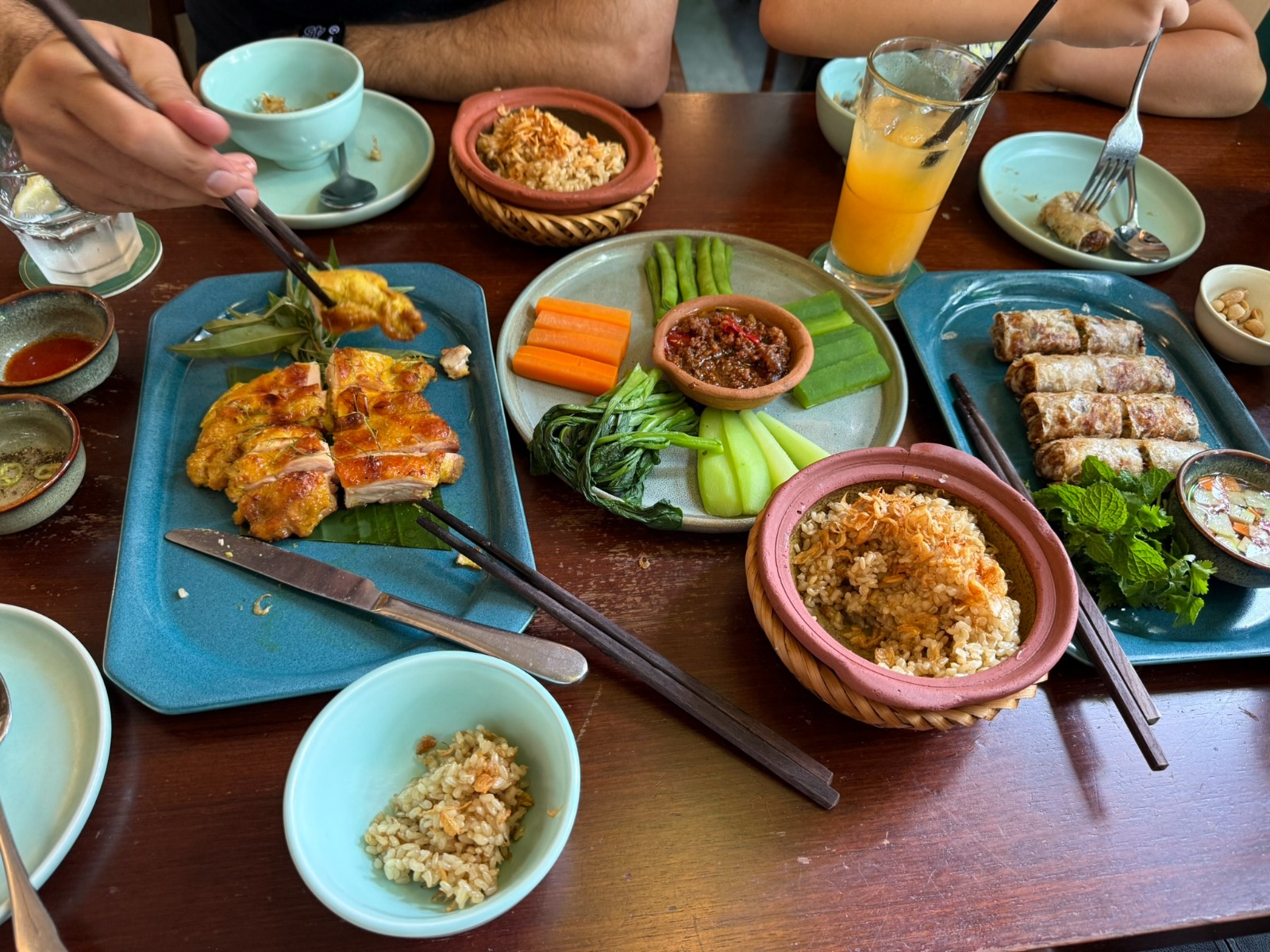
Vietnamese food needs no introduction — so why not explore your neighbourhood and settle in for a delicious meal after checking in?
The rest of the day is free for you to relax or explore - perhaps wandering through Hanoi’s Old Quarter, with its narrow streets, buzzing cafés, and endless little shops full of character.

It’s time to roll up your sleeves - from banana leaf salad to crispy spring rolls and aromatic Bun Cha - get ready for a delicious morning with a traditional cooking class.
For your authentic culinary experience, we partner with Rose Kitchen, the no.1 cooking class provider in Hanoi. Today you will be picked up at your hotel by shared transfer. Head straight to a local market to purchase ingredients for the class and learn about produce integral to Vietnamese cuisine. Learn to cook in a local luxurious villa of 500m2 with a local chef. In the kitchen, you’ll prepare and cook authentic dishes, such as spring rolls, a salad of banana flowers, and barbecue pork with noodles and fish sauce. Once you’ve finished cooking, you’ll sit down to feast on the fruit of your labour.
In the afternoon visit the 11th century relic, the Temple of Literature, which was built in homage to the Chinese scholar Confucius. Take a breezy cyclo ride through the Old Quarter’s 36 streets, named after the products that were sold from their shops. Today, vendors on Tin and Bamboo Streets still sell the same wares.
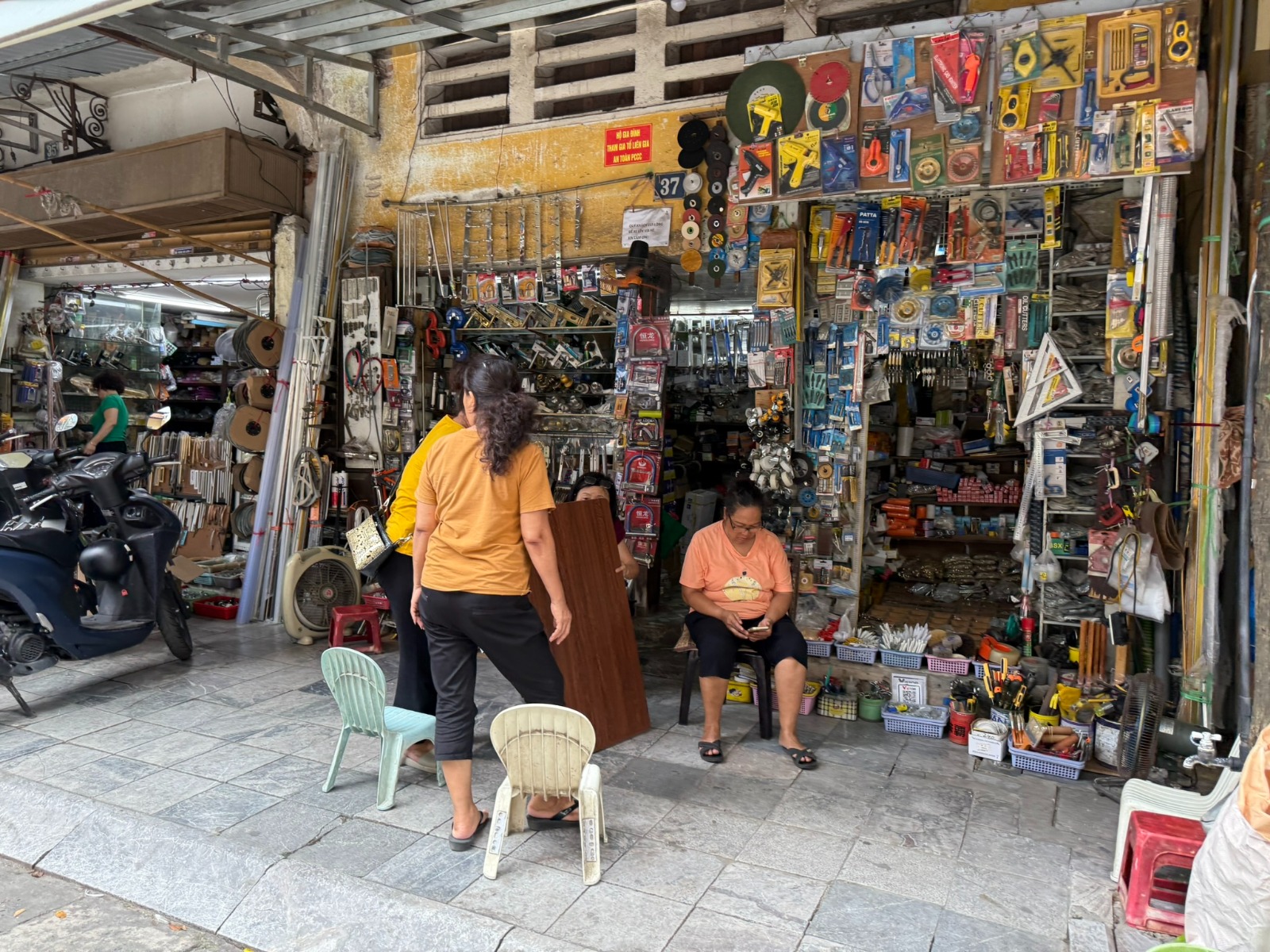
In the Old Quarter, each street is dedicated to a particular craft or trade. In Vietnam we say “buôn có bạn, bán có phường,” meaning “in business, you thrive with companions; in trade, you prosper within a guild.” The featured picture was taken on Hàng Bồ Street, now known for its hardware shops - packed with tools, from saws and wrenches to sandpaper, screws, and every small fix-it part imaginable.
Next, sip a strong Vietnamese coffee at a traditional coffee house.
In the evening you will be transferred to the station for your overnight train to Sapa.
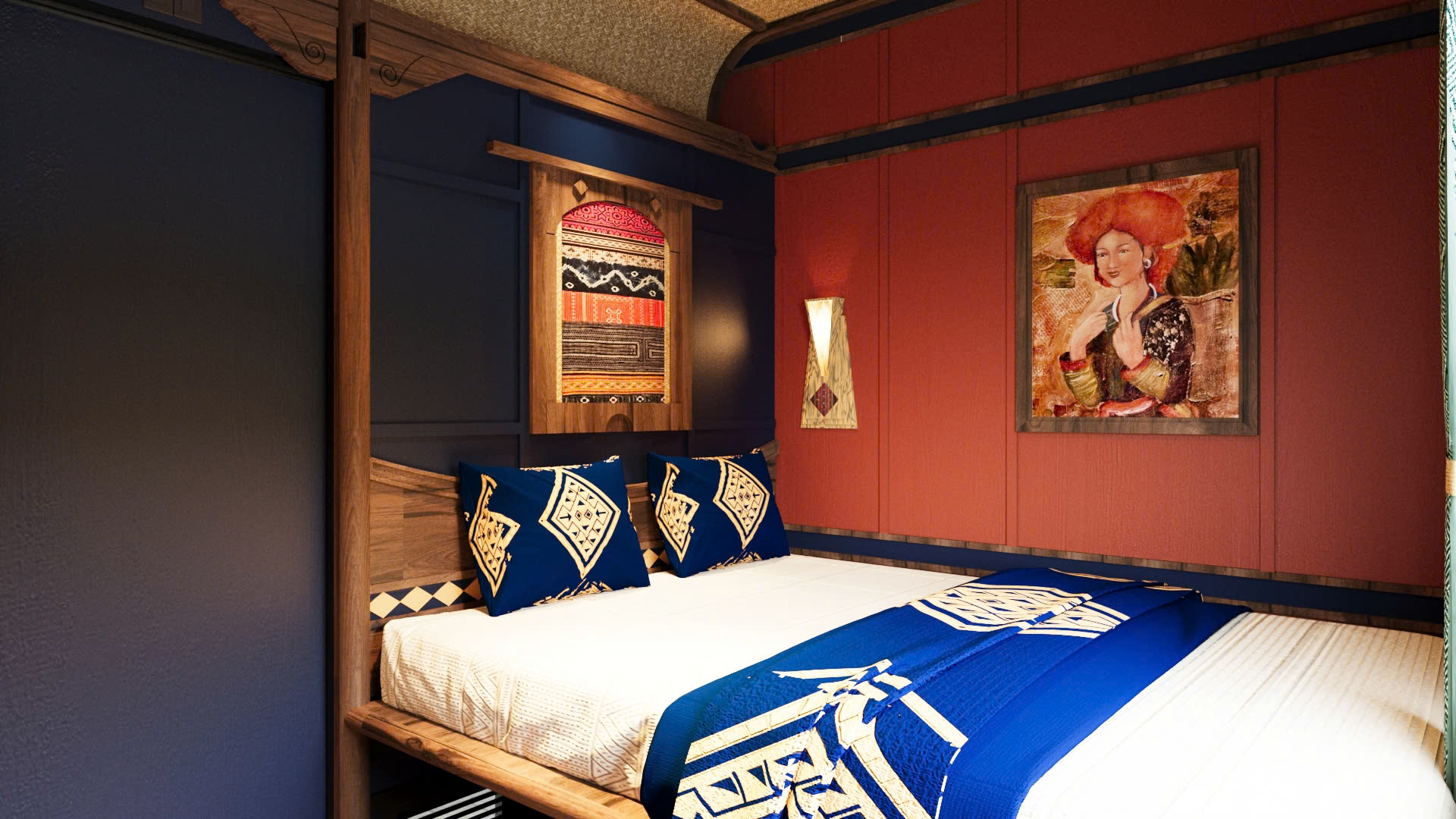
The suite cabin on the Chapa Express - warm, cozy, and ready to cradle you through an overnight ride to the mountain
Tip no.1: If you're a history enthusiast, consider swapping the cooking class for a historical tour. Explore the Ho Chi Minh Complex, delve into the stories of the Hoa Lo Prison (known as "Hanoi Hilton"), and discover the ancient Imperial Citadel of Thang Long, built during the 11th century by the Vietnamese Ly Dynasty. Alternatively, extend your stay in Hanoi to ensure you don't miss out on any experiences.
Tip no.2: Consider leaving your bulky luggage at your hotel in Hanoi and opt for just a backpack, sturdy hiking boots, and a lightweight rain jacket when traveling to Sapa.

A sunlit mosaic of terraced fields and misty mountains — Sapa at its most breathtaking.
Upon your early arrival at Lao Cai station (5:55 am), our guide will warmly welcome you and transfer you to your hotel. Enjoy an early check-in with breakfast, allowing you to unwind before your afternoon tour. In the afternoon, our guide will meet you at your hotel and escort you to a local restaurant for lunch.
Following this, embark on a half-day guided tour to Sapa's Love Waterfall. A 40-minute drive brings you to Tram Ton Pass, the highest pass in Vietnam at 2047 meters above sea level. Revel in breath-taking views of the surrounding mountains and lush forests of the Hoang Lien National Park.
Take a 30-minute walk to appreciate the stunning scenery on both sides of the Hoang Lien Son mountain range, where the wind plays with the clouds, creating a mesmerizing spectacle. Continue your adventure with a 30-minute trek through the forest, surrounded by vibrant wildflowers. Following the stream, you'll reach the magnificent Love Waterfall - a true natural marvel. Standing at 100 meters tall, the waterfall sparkles in the sun, with water cascading into a golden stream, set against a backdrop of lush greenery and thick bamboo. It's an enchanting sight that captures the beauty of Sapa's landscapes.
Tip: If you'd like to witness the mesmerizing golden rice paddies, consider visiting Sapa in August or September
%20-%20SAPA.jpg)
The Red Dao are the second-largest ethnic group in Sa Pa after the H’Mong. Originally from Yunnan, China, they are part of the wider Dao ethnic community that migrated into northern Vietnam over several centuries — from as early as the 13th century up to the 1940s.
Begin your morning adventure by descending into the enchanting Sa Pa valley, a scenic drive that takes approximately 2 hours. Along the way, be prepared to be mesmerized by the breathtaking vistas of the expansive paddy terrace fields and vibrant cornfields, showcasing the largest terrace paddy in Sa Pa. Pass through Ban Ho village before ascending to My Son Village and Nam Cang Village, nestled at the far end of the valley and home to various ethnic minority groups like Xa Pho, Red Zao, and White H'mong.

A moment of shared laughter in the mountains.
Pause at Nam Than Village before continuing your journey with a hike to Nam Nhiu village, where the Red Dao people reside. Experience the awe-inspiring panoramic views of the towering mountains and immerse yourself in the warmth of the local village atmosphere. Cross a suspension bridge and be greeted by the refreshing sight and sound of small waterfalls along the trek. Prepare to be captivated by the stunning landscape of the lowest valley, adorned with scattered "Buffalo houses on stilts" nestled among the paddy terraces. As you trek, be serenaded by the melodious songs of the forest, the delightful chorus of birdsong filling the air. After approximately 2 hours of trekking, enjoy a hearty lunch in a traditional minority people's house on stilts in Thanh Phu Village. Conclude your day by returning to Sapa, where you can witness the mesmerizing sunset over the picturesque mountains.

A bright red mountain train gliding toward Muong Hoa Station, cutting through Sapa’s emerald valleys and cloud-kissed peaks.
Your guide will meet you at your hotel and then you'll begin the walk to Sun Plaza, where you'll board the Electric Mountain train to Muong Hoa station. From there, you'll take the cable car, which spans 6.2 km up to the summit of Fansipan Mountain. The Sun World Fansipan cable car holds a Guinness World Record, and the ride up to the peak is a highlight for many travelers in Sapa. Each car can hold up to 35 passengers.As soon as you leave the station, you'll start floating high above the rice terraces and rocky cliffs below. The large windows of the cable car offer stunning views as you gradually ascend to the towering peak above the clouds.Before reaching the summit of Mt. Fansipan, you'll pass through a serene garden complex, featuring stone paths, ancient Azalea trees, and 18 meticulously sculpted bronze statues. These sculptures guide you to a 21.5-meter celestial Buddha statue, the largest in Vietnam, perched on the mountainside. The surrounding gardens and pagodas offer a peaceful atmosphere where you can relax and enjoy the fresh air.A series of stairs or a funicular railway will take you the final distance to the top of Mt. Fansipan. At the summit, you'll be rewarded with breathtaking, panoramic views of cloud-covered peaks stretching to the horizon.

A sunny day atop Mount Fansipan — the “Roof of Indochina,” where sky, mountains, and the Vietnamese flag meet above the clouds.
The highest point is a popular spot for selfies, but you can also walk the entire platform to take in 360-degree views. The ever-changing cloud formations at the top offer new shapes and scenes as they shift, blending the sky and earth in a beautiful dance. After soaking in the stunning scenery and magnificent views of Sapa and the Lai Chau province, you'll be transferred back to Sapa.
In the evening you will be transferred to Lao Cai station for your train to Hanoi.

Ha Long is synonymous with Vietnam — and for all the right reasons. Her ethereal beauty is truly a sight to behold.
Upon arrival in Hanoi you will be met and transferred to your hotel for breakfast.
After breakfast, depart from Hanoi and travel by road to the Tuan Chau Island pier in Halong Bay. Set off on your luxury cruise, where you’ll be pampered in style and comfort whilst meandering through the towering limestone cliffs and emerald green waters of Ha long Bay. Stop in Tra Bau, a secret hideaway in Lan Ha Bay that has beaches, caves and coves.
You can try kayaking or simply swim in the clear waters of the bay. Back to your boat, enjoy life aboard the vessel or in your suite, and with cocktail in hand watch the sunset over the Gulf of Tonkin. In late afternoon part in a professional cooking demonstration before indulging in a luxurious dinner in the dining hall.

Dine like royalty at Le Tonkin Restaurant on Heritage Cruise.
lSpend the rest of the evening as you’d like: watch a movie in the dining area, relax on the deck with a cocktail, or go squid fishing under the cover of night.
Fact: Ha Long Bay experiences cool weather and clear skies from September to November. Mist rolls in from December to March, lending the bay an air of mystery. April and May bring sunny days and a refreshing breeze, while the monsoon season, occurring from June to August, can make visits unpredictable.
.jpg)
See Ha Long up close with a bamboo boat — a gentle glide through towering karsts and quiet emerald waters.
Rise with the sun and practice Vivonam on the sundeck while taking in majestic views of the surrounding bay and the cool sea breeze. Wrap up your experience with a bamboo boat trip to visit Dark and Bright Cave before cruising back to Tuan Chau Marina. Your guide and driver will take you to Hanoi airport for your flight to Hue.
Upon arrival in Hue you will be taken to your hotel.

Once the heart of the Nguyen emperors’ empire, Hue is a lasting symbol of Vietnam’s imperial history.
Start your tour with the ancient walled Citadel, which was closely modelled along the lines of the Forbidden City in Beijing. You then have a tour of Thien Mu pagoda, one of iconic sights in Hue and An Hien garden house. An Hien garden house contains many large and small architectures built according to the traditional architecture style of Vietnam in general and Hue in particular. The garden house is strongly influenced by fengshui. The main architecture of An Hien garden house is a 3-room 2-gable house with wooden structure and beautifully sculpted patterns. Over a century of existence, An Hien remains almost intact both in landscape and architecture.

The Meridian Gate (Ngọ Môn) is the grand southern entrance to the Imperial City in Huế — an iconic symbol of Vietnam’s imperial past and the ceremonial gateway once reserved for emperors.
For lunch, explore the local street food scene is a must-do activity for travellers in Hue City. Sample the diverse flavours and aromas that make Hue's cuisine so special. From iconic dishes like Bun Bo Hue (spicy beef noodle soup) and banh bot loc, Banh Nam and Banh Beo (Hue royal cakes) to the fragrant com hen (clam rice) and Nem Lui (lemongrass skewers), there are endless culinary delights to savour. As you embark on your culinary journey, you'll also have the opportunity to learn about the cultural significance behind each dish. Many of the traditional recipes have been passed down through generations, offering a glimpse into the city's rich culinary heritage. Venture into the bustling streets, where local food vendors and stalls line the sidewalks, offering a wide array of flavours and textures.

A classic Hue specialty: Banh Nam — silky steamed rice cakes wrapped in fragrant banana leaves, best enjoyed with a light, savory dipping sauce.
In the afternoon visit Khai dinh tomb. Khai Dinh was the Nguyen Dynasty’s most eccentric and unusual king, who reportedly embraced French colonialism. Much like his father, Khai Dinh favored imported luxuries, spent huge sums of money on his tomb, and was the subject of ridicule by nationalist leaders.
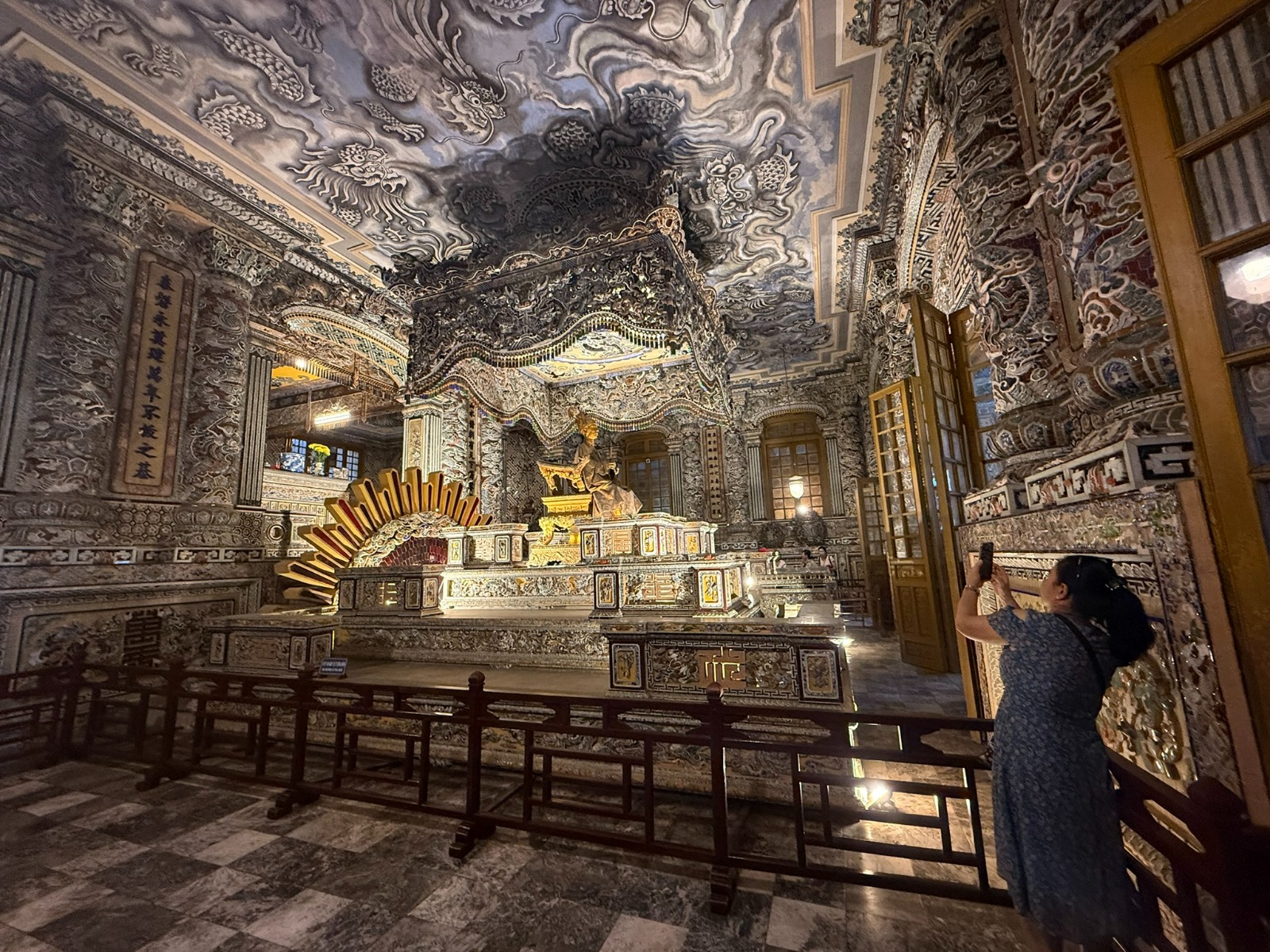
The magnificent Khai Dinh Tomb — a place where splendour knows no bounds. Here stands the most exquisite altar among all those built to honour the Nguyen emperors.
Tip: Did you know that Hue was once the former royal capital of Vietnam and is renowned as one of the country's most remarkable culinary destinations?
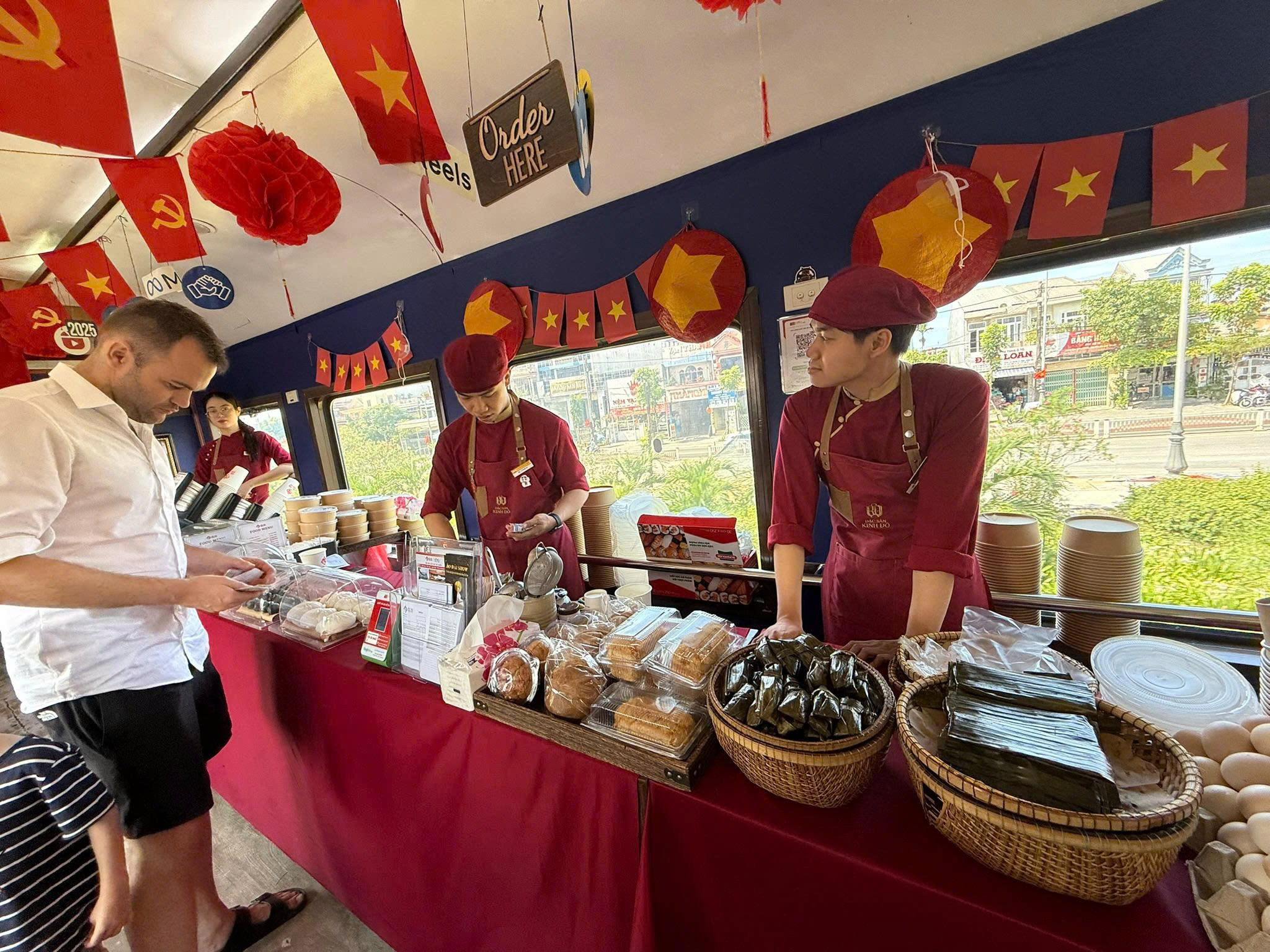
A man buying local snacks on the train from Hue to Hoi An — the car ride may be faster, but the train journey is very memorable.
Today you will be transferred to Hoi An over the scenic Hai Van Pass, probably the most scenic stretch of coastal road in Vietnam.
Visit the Marble Mountains which are a group of five limestone and marble hills in Ngu Hanh Son District. The mountains sheer porous limestone is punctuated by caves and tunnels which are fitted with spectacular Buddhist and Hindu shrines. Check in your hotel in Hoi An. The rest of the day is at leisure.
Tip: For your first night in Hoi An, why not take a leisurely walk or use the hotel's shuttle bus to visit Hoi An Ancient Town? Take in the charming atmosphere, indulge in some delicious local cuisine, and unwind at a riverside bar
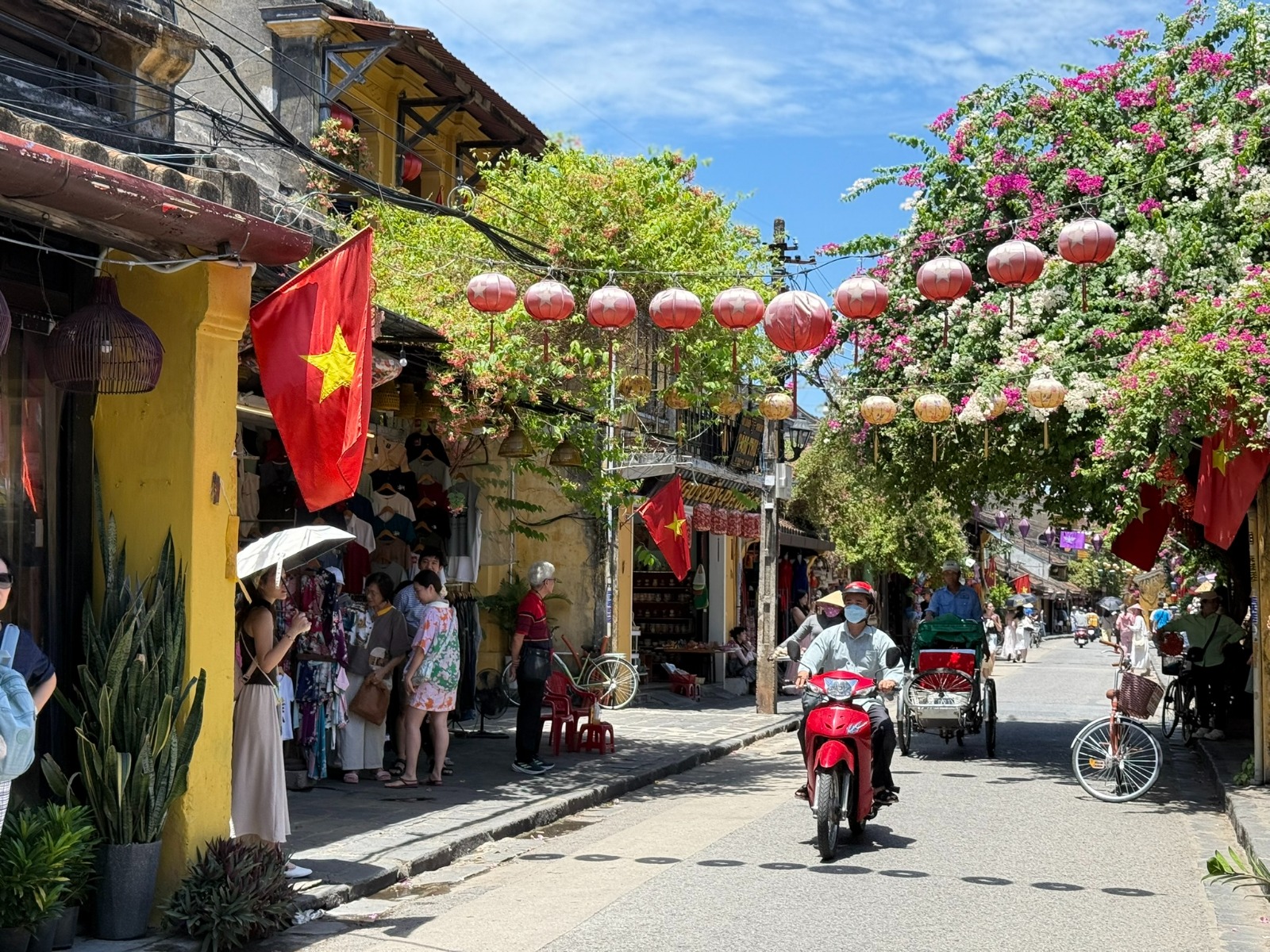
Once hailed as the best city on Earth — Hoi An still charms with lantern-lined streets, golden walls, and timeless, sun-soaked beauty.
Begin your story of Hoi An, a former port that welcomed Chinese, Dutch, French, Japanese, Portuguese and Arab merchants between the 16th to 18th centuries. Today it is renowned for its old quarter lined with two-storey Chinese shops, with elaborate carved wooden facades and terracotta tile roofs. And not forgetting expert tailor shops and delicious food! The tour includes stops at several famous landmarks. The first is Chua Ong Pagoda, dating back to 1653 and built in honor of the Chinese general Quan Cong, who is worshipped by many as a symbol of loyalty and justice. Next, pop into Phuc Kien Assembly Hall, to see the Jinshan Temple which is dedicated to the goddess of the sea and the protector of sailors.
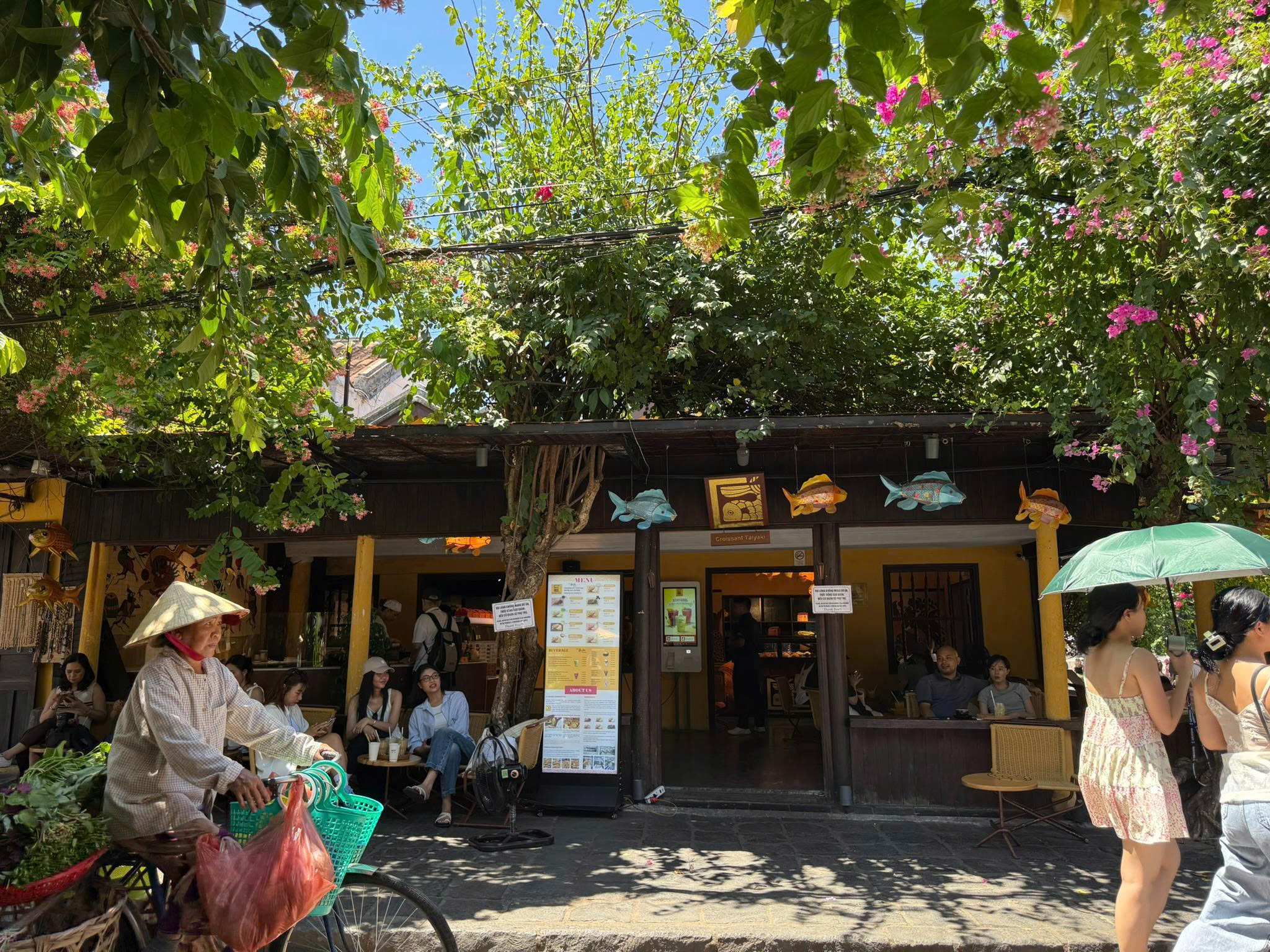
From cosy coffee houses and skilled tailor shops to gourmet restaurants and beloved local hangouts — Hoi An has it all.
From there it’s a short walk to Tam Ky House, a 200 year old ancestral house and finally, stroll across the often photographed 17th century covered bridge built by Japanese craftsmen. The beautifully built bridge doubles as a temple and is a major landmark of Hoi An.

Phuc Kien Assembly Hall — a sophisticated architectural gem blending Chinese, Vietnamese, and Japanese influences into one harmonious masterpiece.
From there it’s a short walk to Tam Ky House, a 200 year old ancestral house and finally, stroll across the often photographed 17th century covered bridge built by Japanese craftsmen. The beautifully built bridge doubles as a temple and is a major landmark of Hoi An.
After a Vietnamese lunch, take a short boat trip down the river and visit a craft village where local artisans make ceramics. End your afternoon with a visit to the docks and see traditional fishing boats and the unusual round basket boats that ply the water.
Tip: If you find yourself with additional time in Hoi An, consider extending your stay for another night. You can unwind with a massage, shop locally, or take a tour to either My Son Sanctuary, an ancient Cham site, or the Golden Bridge, known for its unique design resembling being lifted by two giant hands.

Ho Chi Minh City : shimmering towers, winding streets, and the pulse of Vietnam’s biggest metropolis.
Your guide will meet you at your hotel and transfer you to the airport for your flight Upon arrival, your guide or drive will be waiting to transfer you to your hotel.

Eating snails, or "An Oc," is a beloved pastime in the country, and in Saigon, it has become a cultural staple.
In the evening, sink your teeth into the flavours of the South — from freshly grilled beef wrapped in peppery wild betel leaf to the classic Vietnamese bánh mì and even “rice paper pizza.” Snack on gỏi cuốn and local shellfish, a rustic Saigon favourite. Finish with one of the city’s most beloved dishes: broken rice. Once considered a poor man’s meal, it’s now a Saigon staple, served with roasted pork, pickles, and steamed egg cake drizzled with spring onion oil. After your feast, head to a local night spot for a drink and a chat as the city’s nocturnal energy comes to life.

The Cu Chi Tunnels stretch over 250 kilometers (155 miles) and were built by hand over decades, becoming a crucial underground network used for living, supply routes, hospitals, and military operations during the Vietnam War.
Begin your journey to the Cu Chi Tunnels by departing at around 8am from your hotel and travel through the countryside which was once a stronghold of the Viet Cong. Upon arrival, watch a short video about what life was like for soldiers who lived there during the war. The cramped tunnels were central to a few of the war’s strategic operations, including the famous 1968 Tet Offensive, and they didn’t escape damage. American B52 bombers dropped hundreds of missiles leaving huge tell-tale craters behind. The tunnels served not only as living quarters, but as supply routes and hospitals for thousands of guerilla fighters. Many died there from malaria and other diseases, and a few were also born or married. Today they are viewed by some as a testimony to the Vietnamese people’s resiliency.

Reunification Palace - once a symbol of the South Vietnamese Government. It was here on 30 April 1975, that the war ended when a North Vietnamese Army tank crashed through its gates.
In the afternoon enjoy a half day walking tour of Saigon. Start your Story of Saigon with a visit to the War Remnants Museum. Here, your guide will tell the story of the city’s darkest and most tragic hours during the Vietnam War. The museum contains displays of military aircraft, weaponry and many photographs - some that are quite graphic in nature. Although many of Vietnam’s 90 million people are now too young to remember the war, its legacy is still felt strongly across Vietnamese society. Next, visit the Reunification Palace, once a symbol of the South Vietnamese Government. It was here on 30 April 1975, that the war ended when a North Vietnamese Army tank crashed through its gates. See the war room, the banquet hall and the presidential office with the unusual gifts which have been received. Then, continue to the Central Post Office, designed and constructed by the renowned architect Gustave Eiffel, and take a moment to send a postcard!

Notre Dame Cathedral — red bricks, twin towers, and timeless elegance amid the city’s bustle..
Just behind the post office is the Notre Dame Cathedral, an iconic Saigon landmark built in neo-Romanesque style by the French between 1863 and 1880. Today it’s a favoured backdrop for Vietnamese wedding photographs.Next, stroll down follow Dong Khoi Street, which figured prominently in Graham Greene’s famous Vietnam novel, The Quiet American, as Rue Catinat. The walk ends at the Saigon Opera House. From a bomb shelter to housing the parliamentary Lower House, the Opera House has had an interesting history.

A morning in the Mekong.
A short 2 hour car transfer delivers you to the pristine natural beauty that is Ben Tre Province. Known as “Coconut Island,” many of its people still rely on tradition and centuries old methods of production. Visit Monkey Bridge, or "Cầu Khỉ" in Vietnamese, a traditional and picturesque type of bridge found in the Mekong Delta region of Vietnam. Next, we'll journey to a coconut farm, immersing ourselves in local life and witnessing first hand the coconut production process. You'll have the opportunity to learn about the making of coconut products and experience the art of crafting sleeping mats alongside the locals.

The Mekong’s morning rhythm — paddles, produce, and a river bursting with life.
Following this, we'll embark on a tranquil rowing boat ride through the narrow coconut canals, enveloped by lush greenery, before continuing our exploration by motor cart through charming villages and scenic landscapes, providing an authentic glimpse into local culture and fostering interactions with welcoming locals. To conclude our adventure, we'll enjoy a delectable lunch at a local home, savouring traditional Vietnamese dishes crafted from fresh, locally-sourced ingredients. You will then be transferred back to your hotel.
Your guide will meet you at your hotel and transfer you to the airport for your flight.
November - April is the best time to do this itinerary when weather is the most pleasant.
If you don't mind some sporadic rain and hot weather then you can benefit from travelling in green season (May - September) when it is generally less crowded and most hotels offer reduced rates during this time of year.
For more information on weather please visit our Vietnam weather page.
For this itinerary you need to fly into Noi Bai airport (HAN) in Hanoi and out of Tan Son Nhat airport (SGN) in Ho Chi Minh City.
Yes absolutely. The above itinerary is just a suggestion of what you could do. We can take things out or suggest other experiences that are more to your liking.
Vietnam
Visitors from certain countries might enter Vietnam visa-free for a certain number of days.
From 15 March 2022 Vietnam has reintroduced visa waivers for the nationals of some countries including the UK, Germany, Spain, France, Norway, Sweden, South Korea, Finland, Japan, Italy & Denmark., Russia, Belarus (under 15 days); Thailand, Malaysia, Singapore, Indonesia, Cambodia, Laos (under 30 days); Philippines (under 21 days) and Myanmar & Brunei (under 14 days).
If you are not passport holder of the above mentioned countries or if you wish to stay longer than what is allowed then you would need to apply for Vietnam e-visa
E-visa costs 25 USD and generally takes 3 days. You will receive your code by email to print your visa. You can enter Vietnam on an e-Visa at any of the country's eight international airports, including Hanoi, Ho Chi Minh City and Danang, as well as 14 land crossings and seven seaports.
Cambodia
Visitors to Cambodia can obtain a visa on arrival for tourism (US$30) or business purposes(US$35), for a maximum stay of 30 days. Extensions are possible. Passport should be valid at least 06 months before expiry date and 1 passport photo is required.
You can also apply for Cambodia e-visa online.
From 15 May 2022 you no longer need to take a COVID-19 test before travelling to Vietnam.
You also don’t need to provide proof of your vaccination status for entry to Vietnam.
Debit/ credit cards are widely accepted in Vietnam at restaurants, hotels and shops.
For smaller purchases, you can consider taking some USD in cash which you can change to Dong (at your hotel or tourist centres) upon arrival.
If you don't want to take cash you can get a prepaid 'travel money card' which is usually safer and cheaper than using your debit/credit card to withdraw money at ATMs in Vietnam.
ATMs are widely available in Vietnam, especially in big cities like Hanoi, Ho Chi Minh City & Danang. If you travel to more rural areas consider taking some cash with you.
Please fill in our enquiry form and we will send you a quotation within 24h - 48h based on your requirements. Once you're happy with the itinerary and deposit is made we will start booking your holiday and send you a booking confirmation and a detailed invoice.

Whether it is a boutique lodge or a luxury resort, we scrutinize, test, inspect and only work with top 5% of hotels in each region.

We are local.
Our suppliers are local.
We live and breathe our destinations.

Swift communication.
Competitive pricing.
24/7 ground support.
100% stress-free holidays.

We are rated 'Excellent' on Trustpilot, Google Reviews and on our Facebook page. Check us out!